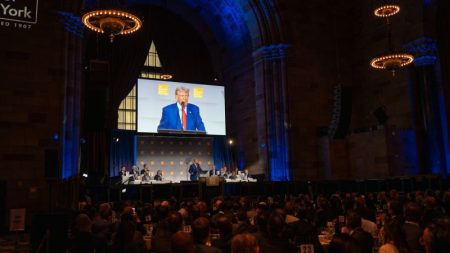Donald Trump and Kamala Harris drew the battle lines this week on the issue US voters say matters most in this year’s presidential election: the economy.
Trump’s top lines came in a long speech to a Wall Street crowd on Thursday — lower taxes, cut government spending and Elon Musk will help him execute an aggressive deregulatory agenda.
Harris’s message came a day earlier at a New Hampshire brewery. She said she would raise taxes for the wealthy and big companies in order to pay for a wider social safety net, offer tax credits for child care and provide tax benefits for small business owners.
With less than two months until the election, Trump and Harris are offering voters fundamentally different visions of the government’s role, who should pay for it and how to fix America’s high cost of living.
Trump’s recipe to curb inflation involves boosting US energy production — already at a record high — to bring down fuel costs, even though the national average has recently drifted below $3.30 a gallon. The federal government would spend less, too, and Musk would find regulations to scrap.
Trump would extend tax cuts he passed in 2017 that otherwise expire next year and then cut more.
“My plan will rapidly defeat inflation, quickly bring down prices and reignite explosive economic growth,” he said on Thursday, a sentiment that many economists dispute.

Harris has stuck with the Biden administration’s approach to lowering US living costs, with targeted measures to cut the prices of everyday items such as prescription drugs. During her time in office, the cost of insulin has been capped at $35 for seniors, for example, but Harris has pledged to cap it at that price for everyone and accelerate the speed of government negotiations with pharmaceutical companies to lower medicine costs.
She also wants to crack down on price gouging by companies, triggering alarm among economists opposed to the notion of price controls, though she has yet to flesh out her plan in detail.
Like Trump, she has proposed building more homes to lower housing costs but also wants to offer up to $25,000 to some first-time buyers to help them purchase property.
She has said the Biden administration’s plans are anti-inflationary. “I’m very proud of the work that we have done that has brought inflation down to less than 3 per cent,” Harris told CNN last week, even though more than a year of high interest rates arguably played a bigger role.
On foreign trade, there are nuances. Harris said on Monday she opposed the planned $15bn takeover of US Steel by Japan’s Nippon Steel, which Trump also opposes. The Biden administration has also enacted sweeping legislation designed to break US dependence on foreign suppliers and recently imposed new duties on some Chinese imports, in addition to most of those made by Trump when he was in office.
But Trump plans to go much further on tariffs than he did in office, proposing levies of 10 to 20 per cent on all imports and 60 per cent on those from China — moves that could reignite trade wars. Many economists said the impact would be negative for the US.
“More protectionism [and] higher tariffs does act as a negative supply shock, which dents growth and lifts inflation, at least over the short term,” said Matthew Luzzetti, chief US economist at Deutsche Bank.
Nomura said the impact of Trump’s tariffs could be muted if domestic distributors absorb the higher cost of imports as was the case in his first term. The investment bank estimated tariffs of 60 per cent on China were unlikely to increase inflation by more than half a percentage point. Annual inflation stands at 2.6 per cent, according to the latest core personal consumption expenditures price index in July.
Economists at Goldman Sachs reckoned every percentage point rise in tariffs would push up inflation by 0.1 percentage point. They also expected Trump’s policies to slow down economic growth in the second half of 2025 by up to 0.5 percentage points. Harris’s plans, they said, would slightly boost GDP growth.
“I don’t know why Goldman hasn’t tried to hire a more balanced economic team,” said Kevin Hassett, who led the Trump White House’s Council of Economic Advisers.
Both candidates’ plans would increase the deficit, according to the Penn Wharton Budget Model at the University of Pennsylvania. But Trump’s plan would add $5.8tn to it over a decade versus Harris’s $1.2tn.
“Deficits are large and they are likely to stay that way in coming years no matter the election outcome,” said Andrew Hollenhorst, Citigroup’s chief US economist.

Ultimately, the outlook for the deficit and the economy will depend on whether either candidate’s party wins control of Congress, which has the final say on most big fiscal changes such as taxes.
“How [Harris] governs is not determined by what she’s saying, it’s determined by what tools she does or doesn’t have,” said Stephen Myrow, managing partner of Beacon Policy Advisors in Washington.
William Gale, an economist at the Brookings Institution think-tank, said: “I think the things you won’t see if you have Republican control of any of the three chambers [the House, Senate and White House], what you won’t see is the wealth tax . . . and [higher] capital gains taxes.”
Harris has already moved towards the centre on tax this week, proposing to raise the capital gains tax from 20 per cent to 28 per cent, rather than to 39.6 per cent as proposed by President Joe Biden. This could potentially make her plan easier to pass through Congress.
“I think the biggest question is, what are going to be the tax increases that are going to be necessary to pay for a lot of the expansions to federal social benefits that we expect her to propose or support throughout the campaign,” said Bernard Yaros, lead US economist at Oxford Economics.
Read the full article here




